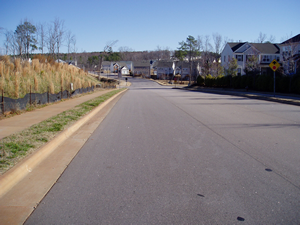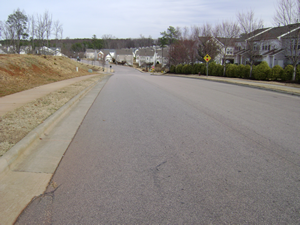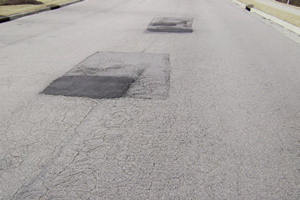 |
TenCate™ develops and produces materials that function to increase performance, reduce costs and deliver measurable results by working with our customers to provide advanced solutions. The following case study details a Raleigh, North Carolina site revisit to inspect the integrity of a flexible pavement installation from January 2003, and to observe how another site that did not use geosynthetics has held up.
THE CHALLENGE
The contractor had to complete roughly one-half of a mile of flexible pavement roadway in January of 2003. The two roads, Marvino Lane and Country Trail, are the main collector roads that service the 300+ home and strip mall development.
To make matters worse, this area’s natural soil deposits have high silt contents which tend to be problematic for the longevity of flexible pavements.
Due to the probable inconsistencies in the subgrade soils, especially during winter construction, the city required the contractor to use a biaxial geosynthetic placed under the 8″ of graded aggregate base course typically required. While little strain would be induced in the geosynthetic during installation (unlike stabilization applications), the addition of a high tensile modulus geosynthetic that also separates would provide additional benefits to the pavement when the subgrade soils soften and lose support over time.
Most of the subgrade soil conditions appeared to be relatively firm during the construction of the flexible pavement. The wide rolls of Mirafi® HP370 allowed the contractor to place the panels three wide with the required amount of overlap on these wide collector roads. The use of TenCate Mirafi® geosynthetics allowed the contractor to maintain the flexible pavement construction schedule for the project.
THE FOLLOW-UP
When our original case study was completed in February of 2007, photos were taken of a representative area on Country Trail where the geosynthetic was used as well as a section of Parkstone Drive constructed without the benefit of a geosynthetic about 6 months prior.
 |
 |
In February of 2011, these same areas were investigated and new photos were taken noting any changes that have occurred. The sections of Country Trail and Marvino Lane where the Mirafi® HP370 was installed showed no major pavement deterioration. The asphalt has shown a bit of wear, but nothing that would indicate a deteriorating subgrade or any base course problems. The Parkstone Drive area constructed without a geosynthetic has continued to deteriorate. It appears as though a section of the pavement has been replaced and areas adjacent to the repair are starting to show major signs of fatigue. Another area of pavement with signs of premature deterioration was observed further into the development on Country Trail, beyond where geosynthetics were used. This part of Country Trail was built approximately 1 year after the first pavement areas that incorporated geosynthetics.
THE PERFORMANCE
 |
Roadway areas that used Mirafi® HP370 continue to perform much better than the other areas that did not use any geosynthetics in their construction. In addition, the pavement sections where Mirafi® HP370 was used look to have a higher ADT than the other two areas. The ability of the geosynthetic to provide reinforcement, confinement of the graded aggregate base course and separation of the base course from the silty subgrade conditions added over 10% to the structural number of the unreinforced pavement section. This additional structural number benefit nearly doubles the allowable ESAL’s under the same subgrade conditions.
Using standard installation costs associated with the base course and asphalt, the unreinforced section costs were approximately $18/SY. With the installation of Mirafi® HP370 adding less than 20% additional cost, its use was easily justified for the observed increase in each pavement area’s service life.
PROJECT DETAILS
Engineer: Withers and Ravenel
Contractor: Brinley Contracting
Geosynthetic: Mirafi® HP370 (13,700 yd.2)
Installed January 2003
Download a copy of this case study (PDF)
Visit TenCate Geosynthetics online at www.tencate.com.











